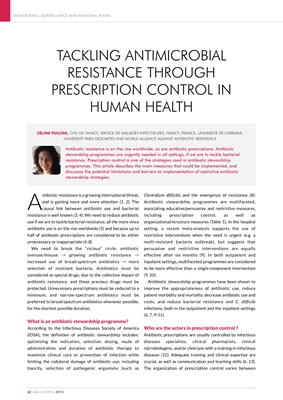
MONITORING, SURVEILLANCE AND NATIONAL PLANS
62 AMR CONTROL 2015
A
ntibiotic resistance is a growing international threat,
and is gaining more and more attention (1, 2). The
causal link between antibiotic use and bacterial
resistance is well known (3, 4). We need to reduce antibiotic
use if we are to tackle bacterial resistance, all the more since
antibiotic use is on the rise worldwide (5) and because up to
half of antibiotic prescriptions are considered to be either
unnecessary or inappropriate (6-8).
We need to break the "vicious" circle: antibiotic
overuse/misuse -> growing antibiotic resistance ->
increased use of broad-spectrum antibiotics -> more
selection of resistant bacteria. Antibiotics must be
considered as special drugs, due to the collective impact of
antibiotic resistance, and these precious drugs must be
protected. Unnecessary prescriptions must be reduced to a
minimum, and narrow-spectrum antibiotics must be
preferred to broad-spectrum antibiotics whenever possible,
for the shortest possible duration.
What is an antibiotic stewardship programme?
According to the Infectious Diseases Society of America
(IDSA), the definition of antibiotic stewardship includes:
optimizing the indication, selection, dosing, route of
administration and duration of antibiotic therapy to
maximize clinical cure or prevention of infection while
limiting the collateral damage of antibiotic use, including
toxicity, selection of pathogenic organisms (such as
Clostridium difficile) and the emergence of resistance (8).
Antibiotic stewardship programmes are multifaceted,
associating educative/persuasive and restrictive measures,
including prescription control, as well as
organizational/structure measures (Table 1). In the hospital
setting, a recent meta-analysis supports the use of
restrictive interventions when the need is urgent (e.g. a
multi-resistant bacteria outbreak), but suggests that
persuasive and restrictive interventions are equally
effective after six months (9). In both outpatient and
inpatient settings, multifaceted programmes are considered
to be more effective than a single-component intervention
(9, 10).
Antibiotic stewardship programmes have been shown to
improve the appropriateness of antibiotic use, reduce
patient morbidity and mortality, decrease antibiotic use and
costs, and reduce bacterial resistance and C. difficile
infections, both in the outpatient and the inpatient settings
(6, 7, 9-11).
Who are the actors in prescription control ?
Antibiotic prescriptions are usually controlled by infectious
diseases specialists, clinical pharmacists, clinical
microbiologists, and/or clinicians with a training in infectious
diseases (12). Adequate training and clinical expertise are
crucial, as well as communication and teaching skills (6, 13).
The organization of prescription control varies between
TACKLING ANTIMICROBIAL
RESISTANCE THROUGH
PRESCRIPTION CONTROL IN
HUMAN HEALTH
CÉLINE PULCINI, CHU DE NANCY, SERVICE DE MALADIES INFECTIEUSES, NANCY, FRANCE; UNIVERSITÉ DE LORRAINE,
UNIVERSITÉ PARIS DESCARTES AND WORLD ALLIANCE AGAINST ANTIBIOTIC RESISTANCE
Antibiotic resistance is on the rise worldwide, as are antibiotic prescriptions. Antibiotic
stewardship programmes are urgently needed in all settings, if we are to tackle bacterial
resistance. Prescription control is one of the strategies used in antibiotic stewardship
programmes. This article describes the main measures that could be implemented, and
discusses the potential limitations and barriers to implementation of restrictive antibiotic
stewardship strategies.